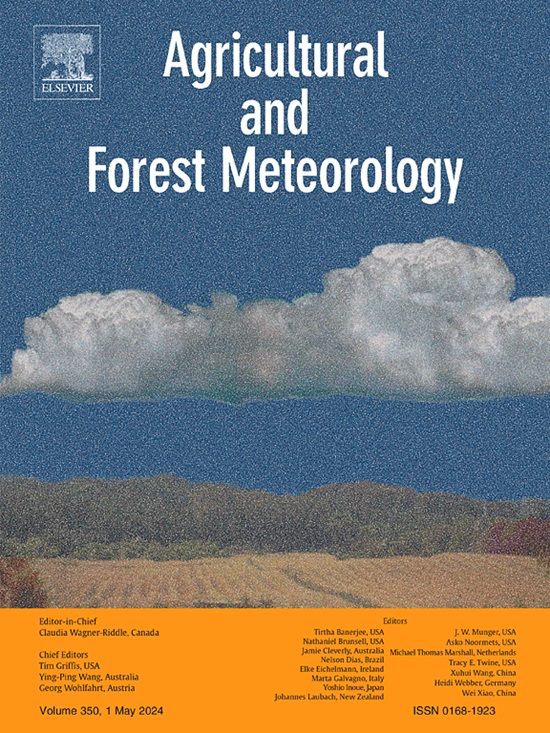Direct and indirect effects of spring phenology on forest transpiration
IF 5.7
1区 农林科学
Q1 AGRONOMY
引用次数: 0
Abstract
Vegetation phenology serves as a crucial impact on terrestrial ecosystem, yet its long-term effects on hydrological process, especially seasonal transpiration changes, remain understudied compared to the extensive vegetation-carbon coupling. Here, leveraging long-term solar-induced chlorophyll fluorescence (SIF) and satellite-retrieved vegetation transpiration (TR) datasets, we assessed the response of vegetation transpiration to phenology change during the start of the growing season (SOS) and peak of season (POS) spanning 1982‒2018 in China. By decomposing the increase in cumulative TR during SOS and POS into two parts, i.e. the TRpheno due to earlier SOS and TRproduct driven by vegetation productivity, we found that a one-day SOS advancement directly increased TRpheno by 1.80 ± 0.44 mm, while indirectly reduced TRproduct by -1.08 ± 0.80 mm. This indirect effect was due to a higher spring SIF induced by earlier SOS, which accelerated TRpheno but also exacerbated soil moisture depletion, limiting the subsequent TRproduct. The direct and indirect effects of spring phenology on TR was found to strengthen over last 37 years using a 15-year moving window analysis. Additionally, differences among plant species underscored the role of plants hydraulic traits in regulating transpiration. Needleleaf forest exhibited a smaller increase in SIF and positive relationship between SIF and soil moisture, thereby mitigating the moisture constrain on TRproduct increasing (coefficient = 0.11, p < 0.05). Our findings highlighted the phenological feedback on hydrological cycle through plant transpiration processes, emphasizing the importance of accounting for plant-environmental interactions in hydrological projections under climate change.
春季物候对森林蒸腾的直接和间接影响
植被物候对陆地生态系统的影响至关重要,但与广泛的植被-碳耦合相比,植被物候对水文过程的长期影响,特别是季节蒸腾变化的影响尚不充分。利用长期的太阳诱导叶绿素荧光(SIF)和卫星反演的植被蒸腾(TR)数据集,我们评估了1982-2018年中国生长季节开始(SOS)和季节高峰(POS)期间植被蒸腾对物候变化的响应。通过将SOS和POS期间累积TR的增加分解为两个部分,即早期SOS导致的TRpheno和植被生产力驱动的TRproduct,我们发现SOS提前1天直接增加TRpheno 1.80±0.44 mm,间接减少TRproduct -1.08±0.80 mm。这种间接影响是由于早期SOS引起的较高的春季SIF,这加速了TRpheno,但也加剧了土壤水分枯竭,限制了随后的TRproduct。利用15年移动窗口分析,发现春季物候对土壤水分转化率的直接和间接影响在过去37年中都有所增强。此外,植物物种间的差异强调了植物水力性状在调节蒸腾中的作用。针叶林的SIF增加幅度较小,且SIF与土壤湿度呈正相关,从而减轻了水分对trf增加的约束(系数= 0.11,p <;0.05)。我们的研究结果强调了通过植物蒸腾过程对水文循环的物候反馈,强调了在气候变化下水文预测中考虑植物-环境相互作用的重要性。
本文章由计算机程序翻译,如有差异,请以英文原文为准。
求助全文
约1分钟内获得全文
求助全文
来源期刊
CiteScore
10.30
自引率
9.70%
发文量
415
审稿时长
69 days
期刊介绍:
Agricultural and Forest Meteorology is an international journal for the publication of original articles and reviews on the inter-relationship between meteorology, agriculture, forestry, and natural ecosystems. Emphasis is on basic and applied scientific research relevant to practical problems in the field of plant and soil sciences, ecology and biogeochemistry as affected by weather as well as climate variability and change. Theoretical models should be tested against experimental data. Articles must appeal to an international audience. Special issues devoted to single topics are also published.
Typical topics include canopy micrometeorology (e.g. canopy radiation transfer, turbulence near the ground, evapotranspiration, energy balance, fluxes of trace gases), micrometeorological instrumentation (e.g., sensors for trace gases, flux measurement instruments, radiation measurement techniques), aerobiology (e.g. the dispersion of pollen, spores, insects and pesticides), biometeorology (e.g. the effect of weather and climate on plant distribution, crop yield, water-use efficiency, and plant phenology), forest-fire/weather interactions, and feedbacks from vegetation to weather and the climate system.

 求助内容:
求助内容: 应助结果提醒方式:
应助结果提醒方式:


